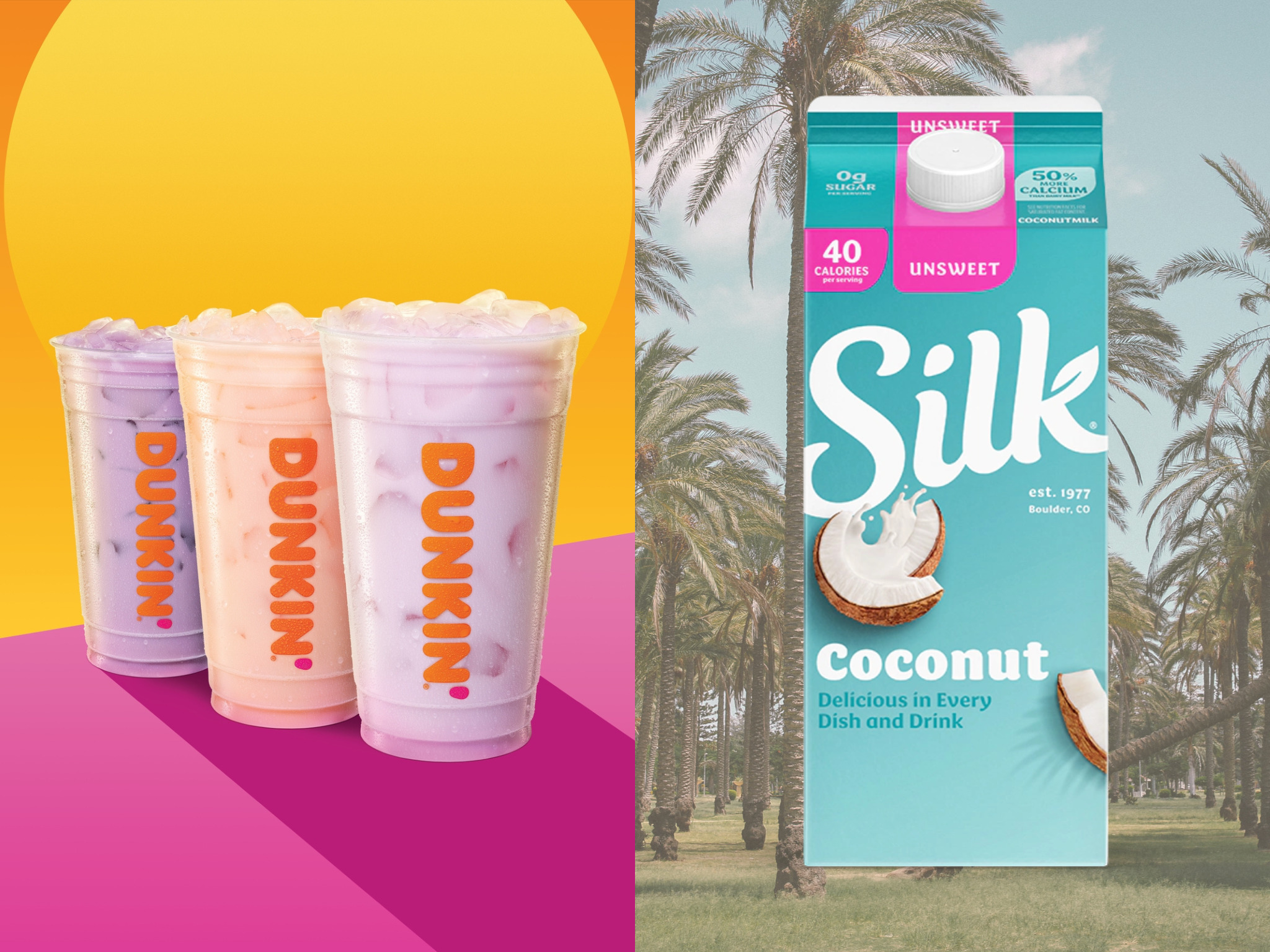7 Mins Read
Coconut milk has been in the headlines after Dunkin’ (formerly known as Dunkin Donuts) announced it’s dropping the dairy alternative from its US menus – but is it actually that unpopular among consumers?
Dunkin’, one of the largest food chains in the world, will soon eliminate coconut milk as a dairy-free option for consumers across its US menu, less than three years after first adding Silk’s Unsweet Coconutmilk as an offering.
The move means Dunkin’s popular Coconut Refreshers range – which mixed coconut milk with fruity iced teas – will exit the menu. The chain will continue to offer oat and almond milk, the latter of which was the first plant-based milk on Dunkin’ menus and will celebrate 10 years since its introduction in 2024.
Why did Dunkin’ bid adieu to coconut milk?
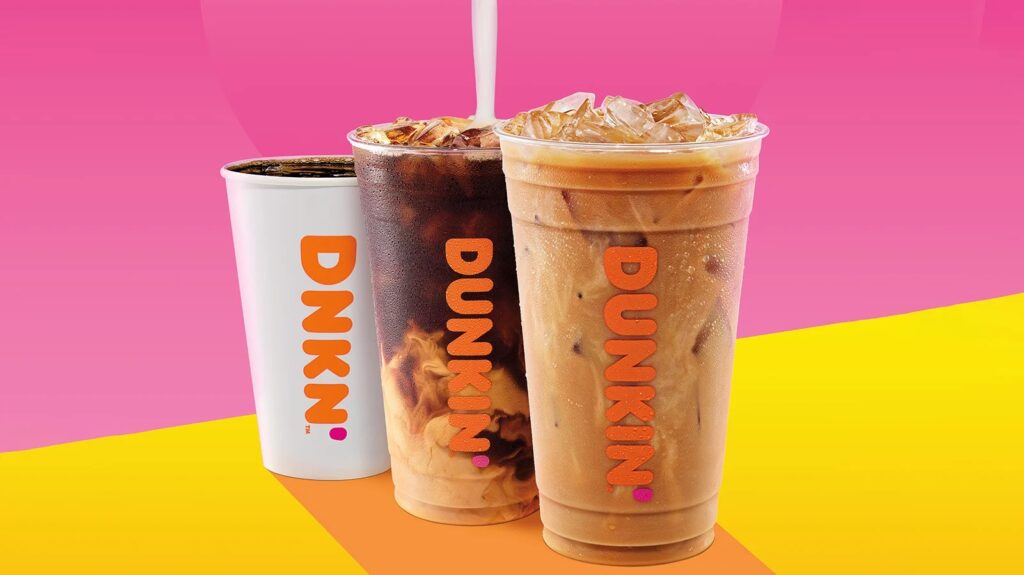
Dunkin’, which has around 13,000 locations internationally, hasn’t specified a reason for cutting coconut milk off its menu but confirmed that people will still be able to order Refreshers with a green tea base.
“Although Dunkin’ is indeed bidding farewell to coconut milk at locations nationwide in 2023, new and exciting beverage innovations are on the horizon in 2024 to provide guests with a growing variety of both coffee and non-coffee drinks to enjoy. Guests will still be able to enjoy all of their favourite Dunkin’ drinks with non-dairy substitutes, including almond milk and oat milk,” the company said.
Usually, when food businesses take permanent items off the menu, it has to do with increased costs, a lack of sales, and/or supply chain issues. Menu data from insights from Technomic’s Ignite platform reveals that the presence of coconut (and soy) milk has been declining from foodservice menus lately, with the former dropping by 0.1% and the latter by 9%. Coconut milk is now present in 10.8% of US restaurants.
In contrast, almond (which has always been the most popular dairy alternative among Americans) and oat milk have been appearing more and more on menus, growing by 6% and 16%, respectively. That said, coconut milk is still the popular alt-milk in restaurants (particularly for cooking purposes), with soy milk only available in 2.2% of eateries, almond milk in 2.1%, and oat milk in just 1%.
Speaking to CNN, Technomic’s consumer and industry insights director, Robert Byrne, said coconut milk is “the most expensive non-dairy milk” for restaurants (almond being the cheapest), which “plays a significant role” in decisions like the one Dunkin’ has made.
Additionally, coconut milk wasn’t very popular with Dunkin’ customers, with only 1% having tried the dairy alternative – that number rises to 5-7% for almond milk and 3% for oat. (Dunkin’ doesn’t offer soy milk.) “It can be difficult to justify carrying multiple nondairy milks when guest demand is less robust,” Byrne said.
Have coconut milk sales dropped?
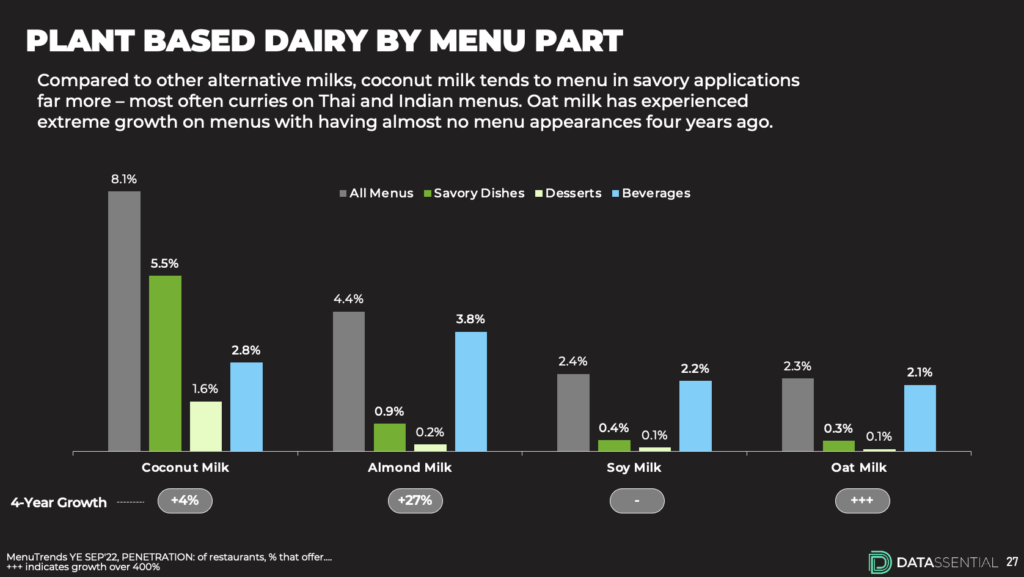
Do consumers really not like coconut milk? It’s a tricky question to answer based on the data available (which is virtually non-existent for foodservice). According to the Plant Based Foods Association, coconut milk reigns supreme when it comes to menu appearances in restaurants, penetrating 8.1% of total locations (almond is present in 4.4%, and oat in 2.3%), as of September 22. This is largely driven by its use in savoury dishes though, as the product is a staple in many South and Southeast Asian cuisines. In terms of beverage use, almond (3.8%) trumps coconut (2.8%).
On the other hand, the results of a 1,328-person survey by Morning Consult published earlier this year reveals that consumer-preference-wise, coconut ranks well below almond and oat (it’s also overtaken by soy for millennials), ahead of cashew, hazelnut and rice milks, which are still on the fringe of the alt-dairy world.
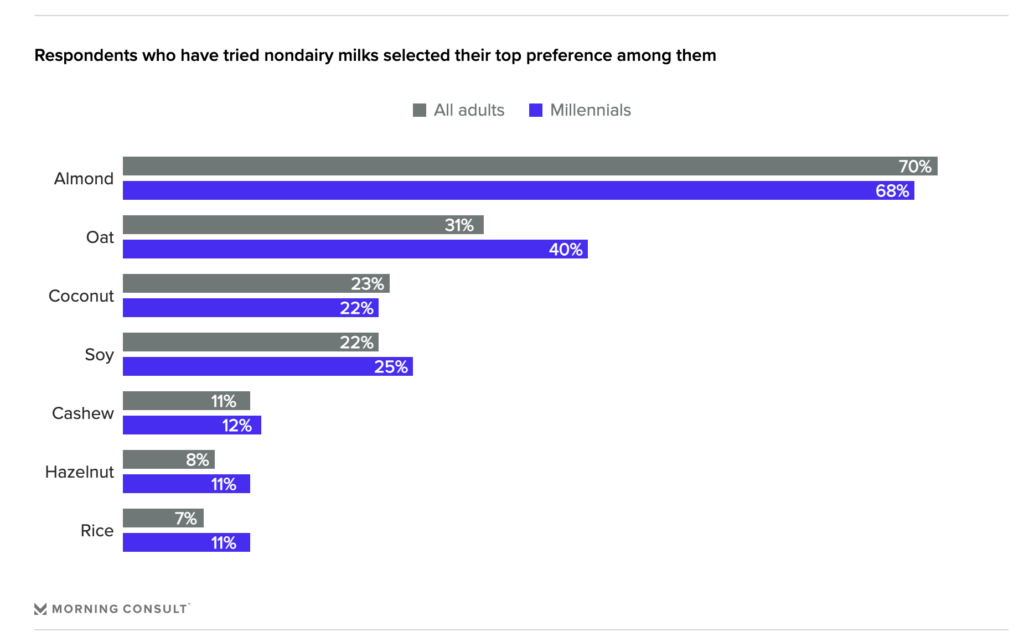
There are mixed results if you look at retail too. A review of Nielsen data by Purdue University found that coconut milk’s dairy alternative market share has reduced from 11.5% to 10.6% from 2018-22 (in that time, oat milk has skyrocketed from 0.7% to 21%).
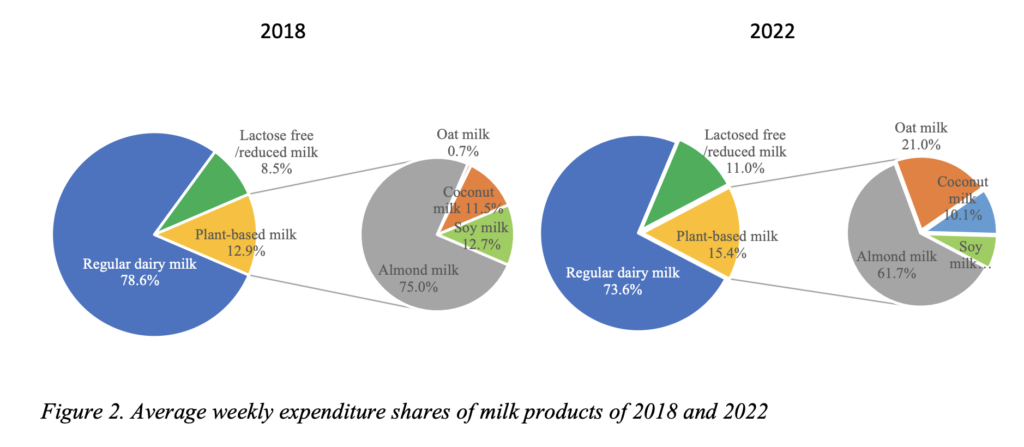
The data chimes with Byrne’s comments as well, calling coconut milk the most expensive alt-milk a $0.094 per ounce, versus $0.05 and $0.052 per ounce for almond and soy, respectively. Coconut milk has seen the largest price hike among both conventional and plant-based milks in the last five years, with average weekly rates up by 33.4% (dairy follows this closely at 33.1%). In comparison, almond is up 7.2%, while oat milk prices have actually fallen by 18.2% thanks to growing demand.
However, if you look at more recent data, shelf-stable coconut milk was the only non-dairy option that saw unit sales rise (by 28.9%) over the 12-week period ending July 16, according to SPINS US retail data shared with AFN. Plus, coconut outgrew all other plant-based milks in year-on-year dollar sales ending on the same date, expanding by 36.5%, compared to 17.7% for oat and only 1.6% for almond. Again, though, its total sales are still the lowest among almond, oat and soy, reaching $146.5M annually, versus $1.56B for almond, $660.5M for oat, and $202.7M for soy.
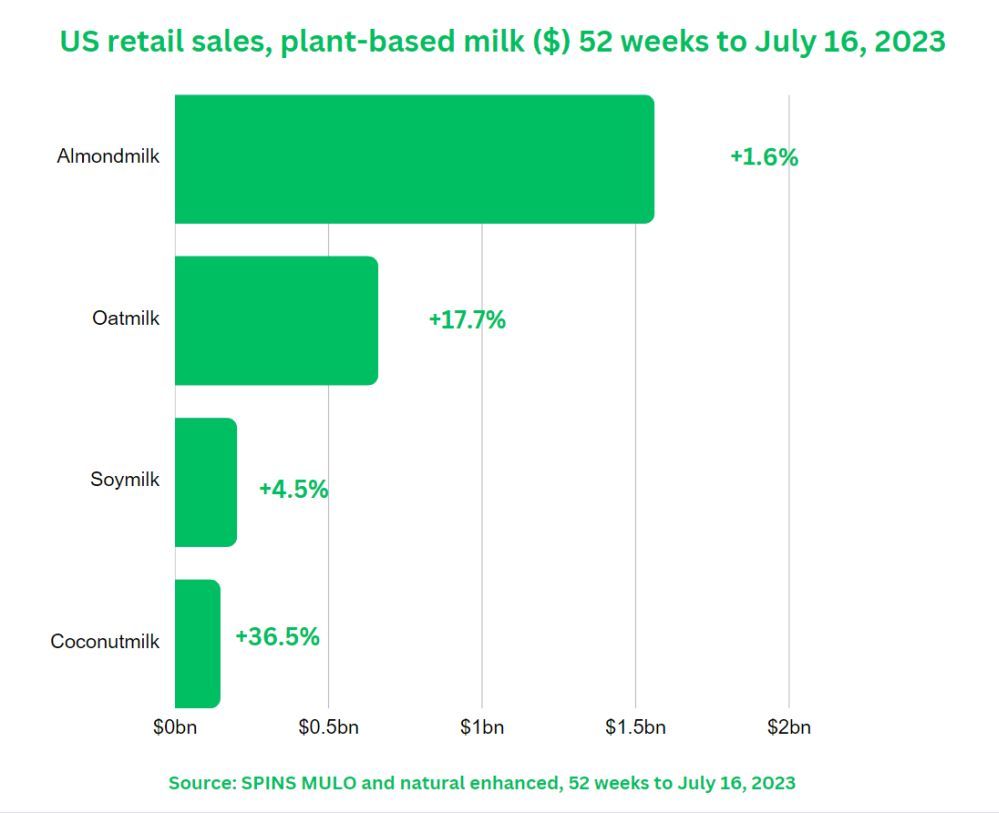
Do people not like coconut milk?
Yes, there are a lot of numbers here, but what actually drives consumer preferences? Studies have shown time and again that taste is paramount. Coconut milk isn’t for everyone, and its strong flavour means it needs to be used carefully in beverage development. Add it to your espresso and you’re tasting more coconut than the actual coffee, for example. Many are looking for alternatives closer to what they’re used to drinking all their lives, and coconut is the dairy alternative furthest from that.
There are also health and environmental issues to take into account. Rice milk, for example, has a huge methane problem – rice accounts for 12% of global methane emissions (and about 1.5% of total GHG emissions). Moreover, it’s high in carbs, while many rice milks have added sugar, which isn’t suitable for many people limiting their intake or with conditions like diabetes.
With almonds – despite being the most popular alternative for years – if they aren’t produced locally, there’s the transport emissions to contend with. If it does come from the US, there’s already a water footprint issue, with a litre of almond milk requiring over 370 litres of fresh water (for context, dairy needs over 625 litres, while oat and soy need less than 50 litres). This is an issue with rice milk too, where almost 270 litres of water make up one litre of finished product.
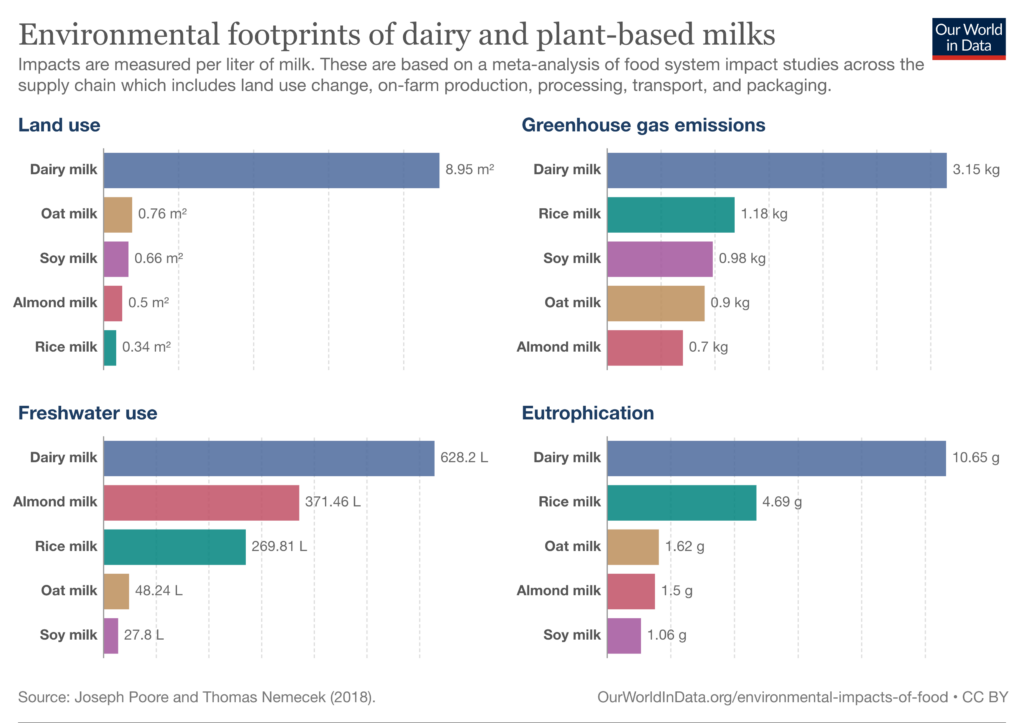
As for soy milk, it’s the most ideal for high protein content, which is comparable to conventional dairy. It’s the original non-dairy milk, but concerns about phytoestrogens (alongside the advent of almond milk) kickstarted a decline more than a decade ago. Lots of people aren’t as keen on its flavour either, with many describing it as ‘beany’.
Back to coconut, it’s a milk much higher in fat content, with greater amounts of saturated fat as well, which can be off-putting to non-dairy drinkers. Coconuts themselves come with some climate and ethical issues, with analysis by climate data startup Calyx revealing that when taking into account factors like biodiversity and animal welfare, using coconut oil can have a lower eco-score than dairy butter in some applications.
Asian coconut milk brands are linked to animal rights abuses, with some forcing monkeys to harvest coconuts in ways that don’t really scream welfare. After an investigation by PETA into the Thai coconut industry, meal kit delivery service HelloFresh dropped Thai coconut milk from its offerings earlier this year. With consumer awareness increasing, some might be becoming averse to this Asian staple.
That leaves us with oat. While oats are not perfect (is anything?), they can lay claim to being one of the most sustainable and ethical alt-milks, with a much more neutral tasting profile that appeals to customers. It’s why Dunkin’ introduced it back in 2020, and why it remains on the menu.
But coconut milk isn’t going anywhere, given its status as a staple in many cuisines, as well as its superior qualities in cooking applications. Whether consumer interest wanes, though, is a different story.


